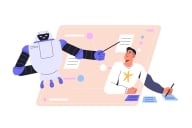You have /5 articles left.
Sign up for a free account or log in.
"But publishers said their biggest hope was that Kindle would expand sales of books to a new generation of gadget lovers."
--The New York Times
When I ask my English students to set learning goals for themselves at the beginning of each term, I’m interested in finding out how they want to improve as readers and writers. I am even more interested in getting at what they think it means to be good readers and good writers.
The most common "reading" goal my students set for themselves is to read faster. Because they have so much going on in their young lives, they are looking for the most efficient ways of getting their reading finished. They also mention that they want to improve their comprehension of what they read, but more importantly they want to learn how do it quickly.
They soon learn I don’t teach speed reading. I teach slow reading. I teach slow, concentrated, finger-on-the-page reading. I read to my students in my slow Texas drawl. I crawl with them through the passages and passageways. We mosey. We copy down sentences. We write paraphrases. We imitate sentences. We read a couple of lines. We ask questions. We pause. We read those lines again. I dedicate entire classes to silent, sustained, shared reading. We call it “reading lab.”
The relationship we have with text is called reading. The quality of that relationship depends upon what we bring to those relationships. Improving the relationships college students have with text is our primary responsibility. And it chiefly occurs when we read to and for them. I know many professors think that students already know how to read when they come to college (or should), but there is a real difference between knowing how to read words on the page and having a productive relationship with those words.
Having a productive relationship with text is also dependent upon hearing the text. Many of my students cannot hear what they read. Perhaps it is because they were not read to as children. Whatever the cause, they often cannot hear the voice of the text. Their eyes may be working, but their ears aren’t. Nothing on the lips and tongue either. What they can’t taste, they can’t consume. That’s why I read to my students. I’m their hearing aid. Their sommelier. Given my experience with the text, I help them learn the lay of the land. I help them find the right narrative path so they can follow it page after page. I’m an English instructor who also teaches voice.
I also know that many students sometimes go blind when they see text. It’s a shameful state of cultural affairs. Poetry-blindness is particularly tragic. Poetry unsettles the eye. It can make us dizzy, all this reading back and forth, up and down the page. But students easily go blind in the face of other texts, too. Lost and wandering aimlessly, they might as well give up, shut their eyes, and fall asleep for good.
So it shouldn’t be surprising that many students should go silent in the company of text. That they are unresponsive in class. That they should go dumb after going deaf and blind. That they have no sense and sensation of what they’ve read. That they look to their professors for short cuts, quick reads, and knowledge patches.
It also shouldn’t be surprising that the solution is to teach students to hear and see and speak the words we assign them. To accomplish this, we not only have to slow down our students, we have to slow down ourselves. Do more with less. At its best, reading should be a sort of textual genuflection, the sign of the cross we make between our eyes, ears, mouth, and mind to enliven the soul.
However, the current frantic pace of school work is not conducive to learning how to read the variety of texts students are assigned across the curriculum. Learning to read well is also dependent on reflection -- time to weigh, consider, accommodate, connect, synthesize, incorporate, sort the wheat from the chaff. If reflection is rarely available (or if there’s rarely time to help students learn how to reflect), then learning to read is rare.
Our learning culture is awash in technology so that information can be delivered in the blink of an eye at any time of the day or night. It's true that more information is flowing, but it doesn't always result in more knowing. In this hypersphere, it may be that students are reading and writing more than ever before. But practice doesn't make perfect. It could just as easily wear us down as lift us up.
This is all a prelude to my short take on Amazon’s new product, Kindle, a wireless and portable handheld device designed to make books instantly accessible. It’s actually a graven image. A false gadget god engineered in the service of efficient data transfer and consumer credit. Don’t be fooled, Kindle is no innocent tool. It's not a gift that keeps on giving. It holds a charge so it can keep on charging.
My dear colleague, you will soon be expected to try it. And then you will be expected to buy it. To embrace its efficiencies and remarkable cost savings. To order your textbooks through it. To order your students to use it.
Someone will put it in your hands. Don’t ask where it came from. Or who made it. Just raise it and praise it, dummy. Look how lightweight and lovely. See how quickly you can turn the page!








